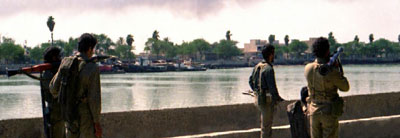
Barcelona, October 6, 2007. I am visiting a museum of photography on a warm autumn Sunday afternoon. I am attracted to the museum by a large vertical banner that advertises its latest exhibition: “Bahman Jalali” written in dramatic red letters.
I enter the exhibit and begin a journey to an exotic Iran of today & yesteryears: Fishermen of Boushehr, Seamen of Khalij, wrestlers of populous neighborhoods, all photographed brilliantly in black & white. In the center of the exhibit are two rooms. I enter the first and find myself in the middle of a slideshow. Four young Catalans, with serious faces, are talking among themselves as each image is displayed. A young Middle Eastern woman is quietly sobbing.
The first photo I see is that of a torso, torn in half, lying by a dirt-filled trench. I am shocked. The next photo appears but the last lingers in my mind. The images are highly graphic. They show a city reduced to rubble. More than that… they are apocalyptic: Ordered Rows of charred palms; Fields of vertically planted burnt automobiles, perhaps to prevent paratroopers landing…
A sign welcoming the road visitor to Khorramshahr… population 149,000. The sign is the only vestige of a highway. Despite being in black and white, the photos do not resemble the historic images of other older wars. They are in sharp focus and full of contrast. They could have been taken yesterday.
As evident from his photographs, Bahman Jalali had extensively travelled the south of Iran prior to the Revolution, and he visited Khorramshahr in 1982 immediately after it was freed from Iraqi occupation.
The images capture the effects of a bloody occupation that resulted in the official changing of the city’s name to Khooninshahr. Khorram can mean joyous or flourishing. Khoonin means bloody.
The struggle for khooninshahr, street to street, house to house, and hand to hand, consumed many brave civilians and defenders. Its liberation, in face of chemical warfare, was also bloody. It was our Guernica, our Stalingrad, our Hanoi. Many young souls, of whatever belief, sacrificed their lives for the liberation of a city.
I leave the museum muttering Simin Behbahani’s poem about the city:
Benvis, Benvis, Benvis…
To the brave defenders of “khooninshahr” and all other bloodied cities of my homeland
Record, Record, Record: An Epic of resilience.
With the gloom of our days,
History, fill your lit chapter.
Record, with whatever means:
The tumult of Young and Old,
Wives and Children, parents and possessions,
Of lives bestowed.
Record: a stone thrown,
Even by a child, playing.
Record: the blow of a pick axe,
Even the aged lending a hand.
Record: it was dismembered
The ivory limb from its body;
Still wearing golden charms,
Still bearing adorned nails.
Record a doll’s plight:
Blood-soaked like its owner.
This, with its dusty form,
That, with dirt filled eyes.
Record how the brush dove
No more enjoyed flight.
Fearful, whirling always at heights,
Much like the predatory hawks.
Record how the cat’s eyes,
Betrayed panic and sorrow.
Mate and mating forsaken,
Cooks and kitchens forgotten.
Praise, Praise the Brave
The Lionhearted, the Hero.
Exalt, exalt the death
Those guardians of the Land.
Record those who uttered:
“Either death or glory”,
Who bravely pressed on till Death.
Record, yes, Record.
November 1980






